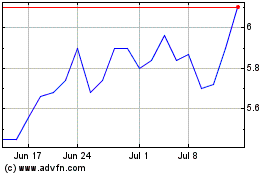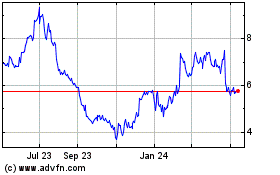Airline Job Cuts Heat Up Aid Discussions
July 16 2020 - 4:43PM
Dow Jones News
By Alison Sider
Airlines are tallying up tens of thousands of job cuts they say
could happen this fall, as Congress gears up to debate offering
more aid to a travel industry crushed by the coronavirus
pandemic.
The $25 billion allocated to U.S. airlines under the $2.2
trillion stimulus package passed in March is set to expire at the
end of September. That money, covering most of airlines' labor
costs for the summer, was intended to be a bridge to better times
by averting an abrupt collapse of the industry.
The problem is the better times haven't arrived. Covid-19
infections are still surging across much of the country, prompting
new restrictions on travel in some cities and states. Air-travel
demand, which had been picking up, shows signs of slumping
again.
And Oct. 1, the date until which carriers had agreed not to lay
off or furlough workers, is fast approaching. American Airlines
Group Inc. and United Airlines Holdings Inc. outlined plans this
week that could result in 61,000 workers being furloughed, though
final numbers could be smaller. Southwest Airlines Co. has also
warned of potential job losses.
"Although furloughs and layoffs remain our very last resort, we
can't rule them out as a possibility obviously in this very bad
environment," Southwest Chief Executive Gary Kelly told employees
earlier this week in an internal message. "We need a significant
recovery by the end of this year -- and that's roughly triple the
number of passengers from where we are today."
Major aviation unions representing pilots, flight attendants and
mechanics are calling for payroll aid to be extended by six months.
Their proposal calls for another $32 billion to be allocated to
passenger airlines, cargo carriers and aviation contractors.
"This is the simplest and fastest way to maintain Congress'
historic commitment to keep aviation workers on payroll," the
unions wrote in a June 25 letter.
Lawmakers will return to Washington next week to begin
negotiations on the fifth coronavirus relief bill, aiming to pass
what would likely be the final aid package before the election in
November. With a federal supplement to unemployment insurance set
to expire July 31 and lawmakers leaving Washington for recess on
Aug. 7, Republicans and Democrats will have just a few weeks to
hash out a host of complicated policy questions.
Among them is whether to offer additional assistance to
industries hammered by the pandemic-induced slowdown. In a $3.5
trillion bill passed by the House in May and immediately rejected
by Senate Republicans, House Democrats sought to extend the
prohibition on involuntary employee furloughs at airline companies
that previously received federal aid. That bill extends the
prohibition until the aid runs out, rather than ending as of Oct.
1. Senate Republicans have said they would consider targeting aid
at troubled industries.
Some lawmakers agree with union leaders that airlines need more
assistance. Rep. Peter DeFazio (D. Ore.) and six other members of
Congress wrote to House and Senate leaders this week urging them to
send more aid for airlines to pay workers.
"While time marches on, so does the pandemic, with hardly any
green shoots sprouting for the airlines," they wrote.
Airlines warned for months that they would have to cut to
survive what is likely to be a yearslong recovery. Some economists
have argued that airlines should be left to retrench rather than
getting another lifeline. Others have suggested it's better to keep
workers tethered to companies as long as possible rather than let
them go, particularly in the event the development of a vaccine
spurs a rapid travel recovery.
Some airline executives have said they're not banking on more
government help. Carriers have raised billions of dollars from
private sources and are also eligible for another $25 billion in
government loans. Those loans don't come with the same restrictions
on job cuts but require airlines to put up more collateral.
Airlines for America, a trade association, said it isn't
actively seeking more aid, though its members support the union
efforts as long as no additional conditions are tacked onto another
round of funds.
Airlines received 70% of the payroll funding as grants. The
other 30% must eventually be repaid, and airlines had to offer
stock warrants to compensate the Treasury. Carriers that have
already taken on large amounts of debt are wary of adding more
while a recovery in demand appears elusive.
Treasury Secretary Steven Mnuchin last week told CNBC that he
considered the payroll aid program a success but said airlines are
among industries that may need more help.
Some airlines are encouraging employees to accept leaves and
early retirements to reduce the number of forced cuts. Under most
union contracts, furloughs start with more recently hired workers
among those let go. Carriers are hoping that employees who are
closer to retirement and more likely to have higher salaries will
take buyout packages to help cut costs.
Some carriers have said they are working with unions on
concessions, such as reductions in guaranteed minimum hours, to
allow more workers to stay on. JetBlue Airways Corp. said earlier
this month that it came to an agreement with its pilots union that
will allow it to avoid furloughs for now in exchange for changes to
their collective bargaining agreement.
Delta Air Lines Inc. has said that 17,000 of its employees have
agreed to leave, but that the company is still asking for more
volunteers.
"We're committed to exhausting every option possible and
harnessing our creativity before we consider involuntary
separations," Delta CEO Ed Bastian wrote in a message to employees
on Thursday.
--Andrew Duehren contributed to this article.
Write to Alison Sider at alison.sider@wsj.com
(END) Dow Jones Newswires
July 16, 2020 16:28 ET (20:28 GMT)
Copyright (c) 2020 Dow Jones & Company, Inc.
JetBlue Airways (NASDAQ:JBLU)
Historical Stock Chart
From Mar 2024 to Apr 2024

JetBlue Airways (NASDAQ:JBLU)
Historical Stock Chart
From Apr 2023 to Apr 2024
